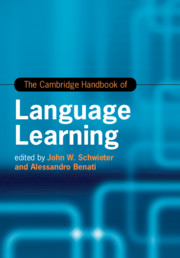Book contents
- The Cambridge Handbook of Language Learning
- Cambridge Handbooks in Language and Linguistics
- The Cambridge Handbook of Language Learning
- Copyright page
- Contents
- Figures
- Tables
- Contributors
- Acknowledgements
- Introduction
- Part I Theories
- Part II Methods
- Part III Skill Development
- 10 Interaction in L2 Learning
- 11 Speaking
- 12 Second Language Listening: Current Ideas, Current Issues
- 13 Contemporary Perspectives on L2 Upper-Register Text Processing
- 14 Language Learning Through Writing: Theoretical Perspectives and Empirical Evidence
- Part IV Individual Differences
- Part V Pedagogical Interventions and Approaches
- Part VI Context and Environment
- Part VII Moving Forward
- Index
- References
12 - Second Language Listening: Current Ideas, Current Issues
from Part III - Skill Development
Published online by Cambridge University Press: 25 June 2019
- The Cambridge Handbook of Language Learning
- Cambridge Handbooks in Language and Linguistics
- The Cambridge Handbook of Language Learning
- Copyright page
- Contents
- Figures
- Tables
- Contributors
- Acknowledgements
- Introduction
- Part I Theories
- Part II Methods
- Part III Skill Development
- 10 Interaction in L2 Learning
- 11 Speaking
- 12 Second Language Listening: Current Ideas, Current Issues
- 13 Contemporary Perspectives on L2 Upper-Register Text Processing
- 14 Language Learning Through Writing: Theoretical Perspectives and Empirical Evidence
- Part IV Individual Differences
- Part V Pedagogical Interventions and Approaches
- Part VI Context and Environment
- Part VII Moving Forward
- Index
- References
Summary
This chapter starts (12.2) by mentioning the drawbacks of the approach conventionally adopted in second language (L2) listening instruction—in particular, its focus on the products of listening rather than the processes that contribute to it. It then offers an overview of our present understanding of what those processes are, drawing upon research findings in psycholinguistics, phonetics, and applied linguistics. section 12.3 examines what constitutes proficient listening and how the performance of an L2 listener diverges from it; and section 12.4 considers the perceptual problems caused by the nature of spoken input. Subsequent sections then cover various areas of research in L2 listening. Section 12.5 provides a brief summary of topics that have been of interest to researchers over the years; and section 12.6 reviews the large body of research into listening strategies. Section 12.7 then covers a number of interesting issues that have come to the fore in recent studies: multimodality; levels of listening vocabulary; cross-language phoneme perception; the use of a variety of accents; the validity of playing a recording twice; text authenticity; and listening anxiety. A final section (12.8) identifies one or two recurring themes that have arisen and considers how listening instruction is likely to develop in the future.
- Type
- Chapter
- Information
- The Cambridge Handbook of Language Learning , pp. 283 - 319Publisher: Cambridge University PressPrint publication year: 2019
References
- 22
- Cited by

